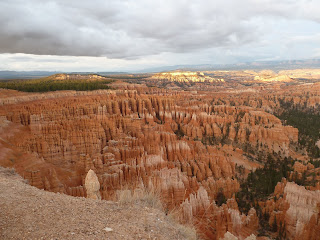Bryce Canyon National Park

 With much grumbling the trio awoke at dawn to make for Sunrise Point to observe that fiery orange orb defy gravity and thrust itself upwards from the horizon. It was 34 degrees Fahrenheit out. Auntie and Matthew were freezing and returned soon thereafter to the warmth of the car; I grabbed the camcorder and fought the growing pain in my frigid fingers to attempt to capture the way the sun's rays were hitting the rocks below.Later that day we drove all the way through Bryce, as recommended by a couple we had met back in Grand Staircase-Escalante, and then stopped at the viewpoints on the way back.
With much grumbling the trio awoke at dawn to make for Sunrise Point to observe that fiery orange orb defy gravity and thrust itself upwards from the horizon. It was 34 degrees Fahrenheit out. Auntie and Matthew were freezing and returned soon thereafter to the warmth of the car; I grabbed the camcorder and fought the growing pain in my frigid fingers to attempt to capture the way the sun's rays were hitting the rocks below.Later that day we drove all the way through Bryce, as recommended by a couple we had met back in Grand Staircase-Escalante, and then stopped at the viewpoints on the way back.
This way, the first real introduction I had to Bryce was at 9,115 feet above sea level—by far the highest I ever recall being. Braving the chill, I propelled myself toward the railing, and the nearer I drew, the further down I could suddenly see. The cliff upon which I stood dropped quickly away, merely the side of an enormous canyon, studded with hoodoos—curiously-shaped tall pinnacles of rock resembling steeples, the graceful results of differential erosion. The line of hoodoos below revealed where the edge of the canyon had previously extended, the rock in between having been eroded by water and time. 
'About 60 million years ago, a large freshwater lake began to fill the low basin that covered most of southern Utah. Over a period of millions of years, rivers and streams surrounding mountains gradually filled this land with clays, silts, and sands. Calcium carbonate cemented these sediments together, forming the limestone layer from which Bryce Canyon has been carved.
'About 16 million years ago the land in southern Utah began to rise. A series of plateaus were uplifted along large cracks in the earth's crust called faults. The Paunsaugunt Plateau, on which you are standing, rose from near sea level to 8,000 feet. To the east, the Aquarius Plateau moved 2,000 feet higher than the Paunsaugunt Plateau.'
As if the panoramic view of the park did not inspire enough wonder, the coloration of the hoodoos was even more dazzling. It was incredible to comprehend that iron oxides and manganese could have reacted in such gorgeous and ever-changing ways, patterning the rocks in unforgettable hues.
The final viewpoint the road offered was the one I had most anticipated: Inspiration Point. A short and strenuous hike brought Matthew and me to an incredible sight that will forever be imprinted in my brain. 
We made it back to the campsite just in time; these dense obsidian-black clouds were the most threatening I had ever seen. Not only did it pour rain, but it hailed. Giant chunks of ice were falling from the sky on our heads. 









No comments:
Post a Comment